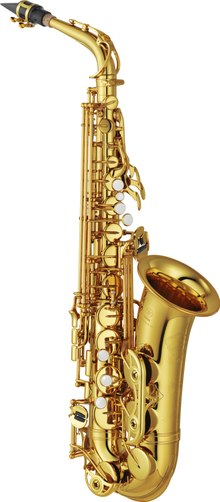Hello ladies and gents this is the viking telling you that today we are talking about

THE SAXOPHONE

The saxophone (referred to colloquially as the sax) is a family of woodwind instruments usually made of brass and played with a single-reed mouthpiece. Although most saxophones are made from brass, they are categorized as woodwind instruments, because sound is produced by an oscillating reed, traditionally made out of woody cane, rather than lips vibrating in a mouthpiece cup as with the brass instrument family.
As with the other woodwind instruments, the pitch of the note being played is controlled by covering holes in the body tube to control the resonant frequency of the air column by changing the effective length of the tube. The player covers or uncovers the holes by pressing keys.
The saxophone is used in classical music (such as concert bands, chamber music, solo repertoire, and, occasionally, orchestras), military bands, marching bands, jazz (such as big bands and jazz combos), and contemporary music. The saxophone is also used as a solo and melody instrument or as a member of a horn section in some styles of rock and roll and popular music. Saxophone players are called saxophonists.
Since the first saxophone was invented by the Belgian instrument maker Adolphe Sax in the early 1840s, saxophones have been produced in a variety of series distinguished by transpositions within instrument sets and tuning standard. Sax patented the saxophone on 28 June 1846, in two groups of seven instruments each. Each series consisted of instruments ranked by pitch, in alternating transposition. The series pitched in B♭ and E♭ soon became dominant and most saxophones encountered today are from this series. Instruments from the series pitched in C and F never gained a foothold and constituted only a small percentage of instruments made by Sax.
High Pitch (also marked "H" or "HP") saxophones tuned sharper than the (concert) A = 440 Hz standard were produced into the early twentieth century for sonic qualities suited for outdoor uses, but are not playable to modern tuning and are considered obsolete. Low Pitch (also marked "L" or "LP") saxophones are equivalent in tuning to modern instruments. C soprano and C melody saxophones were produced for the casual market as parlor instruments during the early twentieth century. Saxophones in F were introduced during the late 1920s but never gained acceptance.
The modern saxophone family consists entirely of instruments in the B♭ – E♭ series, historical and experimental instruments notwithstanding. The saxophones with widest use and availability are the soprano, alto, tenor, and baritone saxophones.
I hope you liked this post and as always have a chilled day fro the Viking
Comments
Post a Comment